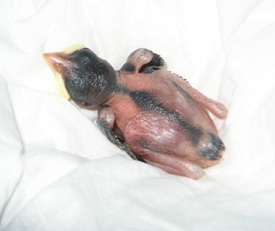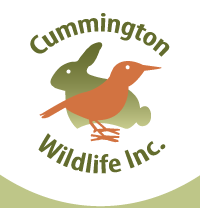

This bird most likely fell from a nearby nest or escaped a predator attack of the nest. If you find a bird with little or no feathers on the ground, the bird needs help. The first step is to place the bird in a “nest” of paper towels/kleenex in a small box. Use gloves or a cloth to pick up the bird. Bring the baby bird inside your house and keep it warm.
One way to keep it warm is to use a hot water bottle wrapped in cloth for the baby to snuggle against. You can also put uncooked rice in a sock and microwave it briefly to create a heat pack. Remember that the goal is a gentle heat for the baby and nothing that will burn tender skin. Take a picture of the bird and contact a wildlife rehabilitator for instructions. Do NOT feed the baby bird or give it water. Birds die easily from stress so the goal is to keep the bird in a warm, dark, and quiet location away from people and pets.
There are a few occasions when a baby bird can be placed back in a nest, but often the baby bird has become injured from the fall. A wildlife rehabilitator can assess whether the baby bird is healthy enough to re-nest or whether the bird needs to come into care.
Please also be aware that birds are susceptible to HPAI (Highly Pathogenic Avian Influenza). This is a highly contagious disease for avian species, such as ducks, chickens, crows, and raptors. Contact the wildlife rehabilitator for instructions if you find a bird that appears ill and you have domestic avian species (ducks, chickens, parrots, etc) in your home. Although this disease has not been prevalent in humans or other mammals, there must be steps taken to minimize risk to you and your pets.
Designing Substitute Nests
Substitute nests are easily created for hatchlings and nestlings using common materials found within the home or a nearby store. Substitute nests are a good option when the entire nest is on the ground due to a windstorm or a tree being cut down. All the baby birds can be placed into the one nest for the parent to continue care.
Here are a few ideas to get you started:
- Take a margarine tub or similar container and punch holes around the bottom for water drainage for an outdoor nest. Without drainage holes, the babies will drown during a rainstorm. This will work for smaller species of birds.
- Take a plastic berry basket that already has drainage spaces built into the design.
- Take a plastic or wicker hanging plant basket. Most of the plastic baskets have drainage holes (or you can punch several at the bottom). I prefer the wicker baskets since they are naturally self-draining and look more natural in the trees.

The ideal nest for nestlings is small enough to provide support at the hip for the bird. The goal is to keep the weight off the bird's weak legs to keep them from being splayed. Nestlings need to be upright in a manner that allows them to open wide their mouths (gaping) for their parents to feed them. They need to be deep enough in the nest so they don't fall out during a wind storm. They need to be high enough in the nest so they can push their bottoms off the side to "poop" outside the nest. This will keep the nest clean and prevent feather damage. Generally, it works to have the nestlings about chest deep in the substitute nest.
Once you have found a suitable container, you will need to add material inside to create a warm, soft environment of the right depth for the nestling. This can be accomplished by using some of the existing nesting material and/or the addition of small, dried twigs. Remember, this nest will be outside and exposed to rain. If you use cloth-like material in the nest, it will become water-soaked and cause the nestling to be cold.
Do not use green lawn grass because the moisture in the grass will also make the nestling cold. Place the materials inside the container and push a depression in the center with your fist.
Once you have lined the substitute nest with appropriate material, it is time to determine the correct location for the nest. The substitute nest should be hung as close as possible to where the original nest had been located. Try to think like a mother bird and place the substitute nest in a manner that makes it difficult for predators (cats and raccoons) to raid the nest. A good option is a thin, but sturdy branch. The nest must be at least eight feet off the ground. Place the nest underneath branches and leaves for protection from sun, rain, and predator exposure. Secure the nest to survive even a windy day. Make sure the nest won't tilt when the adult bird lands on it to feed the young.
Please note that some birds (i.e. woodpeckers) are cavity nesters and make their nests inside trees. In this case, it may be easiest to purchase a nest box from a store and use this as a replacement nest.
There is false information on the internet that an unfeathered bird or poorly feathered bird that fell from the nest can be placed in a substitute nest near where the original nest is located. This does NOT work. A baby bird without full feathers needs to be brooded by the parent(s) to keep warm. A parent bird can not keep babies warm in two separate nests. The parent bird will brood her babies in the original nest and the lone baby in the substitute nest will die from the cold. Please contact the wildlife rehabilitator for advice if you find a hatchling or nestling bird on the ground.
Re-nesting Strategies
A substitute nest can be created after the original nest was destroyed. Parent birds will recognize their nestlings by the sound of their feeding calls. After placing the baby birds in the substitute nest and securing the nest to the tree, it is time to patiently wait and watch. The parents must feel safe before visiting the substitute nest. Therefore, it is important to minimize activity. Sometimes it is possible to watch the nest from a window or a parked car. It may take an hour or more before the parents begin venturing closer and closer to the substitute nest. If the parents have not attempted to feed their nestling in the substitute nest after two hours, it is time to call a wildlife rehabilitator for further instructions.
Do not leave nestlings in an unattended nest overnight. Most songbirds are only active in the daytime and will not be looking for their babies after dark. If reuniting has not been successful after two hours (or after dark), it is time to bring the baby birds back inside to get warmed up again. If the parents begin to feed the nestling, congratulate yourself on reuniting the family!
